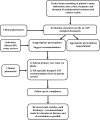The Impact of an Antibiotic Stewardship Program on the Consumption of Specific Antimicrobials and Their Cost Burden: A Hospital-wide Intervention
- PMID: 33061704
- PMCID: PMC7520156
- DOI: 10.2147/RMHP.S265407
The Impact of an Antibiotic Stewardship Program on the Consumption of Specific Antimicrobials and Their Cost Burden: A Hospital-wide Intervention
Abstract
Background: Inappropriate use of antimicrobials (AM) is a major concern worldwide that leads to the propagation of antimicrobial resistance (AMR). In addition to its clinical implications, AMR imposes an economic burden on communities, especially developing countries with more infectious diseases and less available resources. Antimicrobial stewardship programs (ASPs) have been found to be effective in reducing AMR. This study was designed to evaluate the effect of implementing an ASP in reducing AM consumption, its economic burden, and AMR as a consecutive result.
Materials and methods: Consumption of caspofungin, amphotericin B, voriconazole, colistin, linezolid, vancomycin, and carbapenems was compared in a prospective cross-sectional study between two time periods introduced as pre- and post-ASP. Drug use density presented as anatomical therapeutic chemical (ATC)/defined daily doses (DDD) and normalized per 1000 bed days, cost savings, and AMR patterns were evaluated.
Results: A total of 9400 AM prescriptions were analyzed during a 2-year period. Consumption measured in DDD/1000 bed days dropped by 24.8, 25.0, 35.3, 47.0, 39.2, 10.5, and 23.2 percent for amphotericin B, caspofungin, colistin, voriconazole, meropenem, imipenem, and vancomycin, respectively. Linezolid consumption increased by 26.8% after implementing ASP. The expenditure of target AMs in the average value of USD decreased by 41.3% after the intervention compared to the time before using ASP (P-value=0.001). Implementing ASP also increased AM susceptibility of Pseudomonas aeruginosa, while the susceptibility of methicillin-resistant Staphylococcus aureus did not change significantly.
Conclusion: The results of this study suggest that establishment of ASP can lead to a reduction in improper administration of AMs and their expenditure resulting in economic benefit and lowering AMR at hospitals with minimum resources. Clinical pharmacists' role was critical to the success of this ASP and was uniquely empowered at our center.
Keywords: DDD; antimicrobial stewardship programs; antimicrobial use; appropriate prescribing; defined daily dose.
© 2020 Mahmoudi et al.
Conflict of interest statement
The authors report no conflicts of interest in this work.
Figures
Similar articles
-
Impact of antimicrobial stewardship programs on antibiotic consumption and antimicrobial resistance in four Colombian healthcare institutions.BMC Infect Dis. 2022 May 2;22(1):420. doi: 10.1186/s12879-022-07410-6. BMC Infect Dis. 2022. PMID: 35501756 Free PMC article.
-
Impact of an antimicrobial stewardship programme on antimicrobial utilization and the prevalence of MDR Pseudomonas aeruginosa in an acute care hospital in Qatar.JAC Antimicrob Resist. 2020 Aug 7;2(3):dlaa050. doi: 10.1093/jacamr/dlaa050. eCollection 2020 Sep. JAC Antimicrob Resist. 2020. PMID: 34223010 Free PMC article.
-
Educational ICU Antimicrobial Stewardship model: the daily activities of the AMS team over a 10-month period.Infez Med. 2019 Sep 1;27(3):251-257. Infez Med. 2019. PMID: 31545768
-
Systematic Review and Meta-analysis of Clinical and Economic Outcomes from the Implementation of Hospital-Based Antimicrobial Stewardship Programs.Antimicrob Agents Chemother. 2016 Jul 22;60(8):4840-52. doi: 10.1128/AAC.00825-16. Print 2016 Aug. Antimicrob Agents Chemother. 2016. PMID: 27246783 Free PMC article.
-
Antimicrobial stewardship: bridging the gap between quality care and cost.Curr Opin Infect Dis. 2011 Feb;24 Suppl 1:S11-20. doi: 10.1097/01.qco.0000393484.17894.05. Curr Opin Infect Dis. 2011. PMID: 21200180 Review.
Cited by
-
Impact of an antibiotic stewardship program on antibiotic utilization, bacterial susceptibilities, and cost of antibiotics.Sci Rep. 2023 Mar 28;13(1):5040. doi: 10.1038/s41598-023-32329-6. Sci Rep. 2023. PMID: 36977796 Free PMC article.
-
The whole is greater than the sum of its parts: effect of implementing an ABS consultation service in the ABS program on antibiotic consumption at a tertiary military hospital.GMS Hyg Infect Control. 2025 Mar 10;20:Doc11. doi: 10.3205/dgkh000540. eCollection 2025. GMS Hyg Infect Control. 2025. PMID: 40352648 Free PMC article.
-
Evaluation of interventions led by pharmacists in antimicrobial stewardship programs in low- and middle-income countries: a systematic literature review.Antimicrob Steward Healthc Epidemiol. 2024 Nov 11;4(1):e198. doi: 10.1017/ash.2024.342. eCollection 2024. Antimicrob Steward Healthc Epidemiol. 2024. PMID: 39563932 Free PMC article. Review.
-
Barriers, facilitators, perceptions and impact of interventions in implementing antimicrobial stewardship programs in hospitals of low-middle and middle countries: a scoping review.Antimicrob Resist Infect Control. 2024 Jan 23;13(1):8. doi: 10.1186/s13756-024-01369-6. Antimicrob Resist Infect Control. 2024. PMID: 38263235 Free PMC article.
-
Antimicrobial resistance control activities at a tertiary hospital in a low-resource setting: an example of Queen Elizabeth Central Hospital in Malawi.Front Antibiot. 2023 Sep 20;2:1202256. doi: 10.3389/frabi.2023.1202256. Front Antibiot. 2023. PMID: 38077777 Free PMC article.
References
LinkOut - more resources
Full Text Sources
Research Materials


